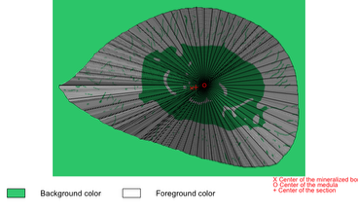Bone Profiler is a scientific method and a software used to model bone section for paleontological and ecological studies.
Bone cross-sections show many characteristics that have been used to infer various properties of the individual or taxon from which they were prepared: life history traits (Castanet et al., 1993), locomotor patterns (Casinos, 1996), lifestyle (Laurin et al., 2000), metabolism (Ricqlès, 1983) or growth rate (Rimblot-Baly et al., 1995) are some examples. However, bone microstructure is very complex, and few objective, quantitative methods (other than very simple ones, like the cortico-diaphyseal index, or the global compactness) are available to describe bone sections in a way that enables statistical inferences or comparison. The main exception is the second moment of area, that has been obtained using software by Ruff and Hayes (1983) and Cubo and Casinos (1998) to assess the strain to which various bones were subjected. However, the programs developed by these authors could not deal with spongy bone. This limitation was not too stringent in these two studies because they dealt with primates and birds, that have little spongy bone (at the mid-diaphyseal level), but it was unacceptable to describe most long bone mid-diaphyseal sections. To modelize bone sections mathematically, we need to reduce their complexity to a limited number of variables that can be further compared using statistical tests. Among the various characteristics of bone sections that could be analyzed, we decided to work mainly on compactness (amount of bone present on a given surface) because this characteristic has been previously suspected to provide much information about the life style of taxa (Laurin et al., 2000). Furthermore, compactness can be measured relatively easily from a bone section (because it only requires knowledge about the presence or absence of bone on a given area). In contrast, bone density requires the use of quantitative micro-radiography that is technically more demanding. An additional advantage of working with compactness is that it can be measured both on extant animals and on fossils. Bone mineral density can usually not be evaluated on fossil bones because of the variable amount of permineralization and other diagenetic phenomena that affect fossil tissues.
Girondot, M. and Laurin, M. 2003. Bone Profiler: a tool to quantify, model, and statistically compare bone-section compactness profiles. - Journal of Vertebrate Paleontology 23: 458-461.
Gônet, J., Laurin, M. & Girondot, M. 2022. BoneProfileR: the next step to quantify, model and statistically compare bone section compactness profiles. Paleontologica Electronica, 25, a12.
This work has been cited by (2003-2010):
Buffrénil, V.D., Canoville, A., D’anastasio, R. & Domning, D.P. (2010) Evolution of sirenian pachyosteosclerosis, a model-case for the study of bone structure in aquatic tetrapods. Journal of Mammalian Evolution 17, 101-120.
Canoville, A. & Laurin, M. (2009) Microanatomical diversity of the humerus and lifestyle in lissamphibians. Acta Zoologica 90, 110-122.
Canoville, A. & Laurin, M. (2010) Evolution of humeral microanatomy and lifestyle in amniotes, and some comments on palaeobiological inferences. Biological Journal of the Linnean Society 100, 384-406.
De Boef, M. & Larsson, H.C.E. (2007) Bone microstructure: quantifying bone vascular orientation. Canadian Journal of Zoology-Revue Canadienne de Zoologie 85, 63-70.
Deschamps, M.-H., Kacem, A., Ventura, R., Courty, G., Haffray, P., Meunier, F.J. & Sire, J.-Y. (2009) Assessment of "discreet" vertebral abnormalities, bone mineralization and bone compactness in farmed rainbow trout. Aquaculture 279, 11-17.
Deschamps, M.-H., Labbe, L., Baloche, S., Fouchereau-Peron, M., Dufour, S. & Sire, J.-Y. (2009) Sustained exercise improves vertebral histomorphometry and modulates hormonal levels in rainbow trout. Aquaculture 296, 337-346.
Deschamps, M.H., Girondot, M., Labbé, L. & Sire, J.Y. (2009) Changes in vertebral structure during growth of reared rainbow trout, Oncorhynchus mykiss (Walbaum): a new approach using modelling of vertebral bone profiles. Journal of Fish Diseases 32, 233-246.
Deschamps, M.H., Kacem, A., Ventura, R., Courty, G., Haffray, P., Meunier, F.J. & Sire, J.Y. (2008) Assessment of "discreet" vertebral abnormalities, bone mineralization and bone compactness in farmed rainbow trout. Aquaculture 279, 11-17.
Germain, D. & Laurin, M. (2005) Microanatomy of the radius and lifestyle in amniotes (Vertebrata, Tetrapoda). Zoologica Scripta 34, 335-350.
Kriloff, A., Germain, D., Canoville, A., Vincent, P., Sache, M. & Laurin, M. (2008) Evolution of bone microanatomy of the tetrapod tibia and its use in palaeobiological inference. Journal of Evolutionary Biology 21, 807-826.
Laurin, M., Canoville, A. & Quilhac, A. (2009) Use of paleontological and molecular data in supertrees for comparative studies: the example of lissamphibian femoral microanatomy. Journal of Anatomy 215, 110-123.
Laurin, M., Germain, D., Steyer, J.S. & Girondot, M. (2006) Microanatomical data and the conquest of land by vertebrates. Comptes Rendus Palevol 5, 603-618.
Laurin, M., Girondot, M. & Loth, M.-M. (2004) The evolution of long bone microstructure and lifestyle in lissamphibians. Paleobiology 30, 589-613.
Laurin, M., Meunier, F.J., Germain, D. & Lemoine, M. (2007) A microanatomical and histological study of the paired fin skeleton of the devonian sarcopterygian Eusthenopteron foordi. Journal of Paleontology 81, 143-153.
Scheyer, T.M. & Sander, P.M. (2009) Bone microstructures and mode of skeletogenesis in osteoderms of three pareiasaur taxa from the Permian of South Africa. Journal of Evolutionary Biology 22, 1153-1162.
Steyer, J.S., Laurin, M., Castanet, J. & De Ricqles, A. (2004) First histological and skeletochronological data on temnospondyl growth: palaeoecological and palaeoclimatological implications. 61st meeting of the Society of Vertebrate Paleontology, pp. 193-201. Bozeman, MT.
Fossil osteoderm from the dwarf pareiasaur Anrhodon serrarlus (Permian, South Africa). The composite image shows the osteoderm in thin-section (foreground photo) and a black-and-white 'shadow' sketch (background) which Indicates the amount of compact bone tissue versus vascular spaces, as used by the program Bone Profller to elucidate the bone compactness parameters of the specimen. From Scheyer & Sander, pp. 1153-1162.

A version coded within R is available as a shiny application:

Version 3.4
January, 2th 2025
